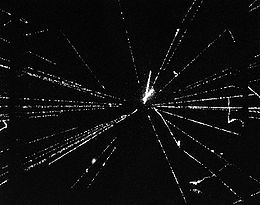
Spark-chamber detector
Encyclopedia

Particle detector
In experimental and applied particle physics, nuclear physics, and nuclear engineering, a particle detector, also known as a radiation detector, is a device used to detect, track, and/or identify high-energy particles, such as those produced by nuclear decay, cosmic radiation, or reactions in a...
, a device used in particle physics
Particle physics
Particle physics is a branch of physics that studies the existence and interactions of particles that are the constituents of what is usually referred to as matter or radiation. In current understanding, particles are excitations of quantum fields and interact following their dynamics...
for detecting electrically charged particles
Subatomic particle
In physics or chemistry, subatomic particles are the smaller particles composing nucleons and atoms. There are two types of subatomic particles: elementary particles, which are not made of other particles, and composite particles...
. They were most widely-used as research tools from the 1930s to the 1960s, and have since been superseded by more sophisticated detectors such as drift chambers and silicon detector
Semiconductor detector
This article is about particle detectors. For information about semiconductor detectors in radio, see Diode#Semiconductor_diodes, rectifier, detector and cat's-whisker detector....
s. Today, working spark chambers are mostly found in science museums and educational organisations, where they are used to demonstrate aspects of particle-physics and astro-physics.
Spark chambers consists of a stack of metal plates, placed in a sealed box filled with a gas such as helium
Helium
Helium is the chemical element with atomic number 2 and an atomic weight of 4.002602, which is represented by the symbol He. It is a colorless, odorless, tasteless, non-toxic, inert, monatomic gas that heads the noble gas group in the periodic table...
, neon
Neon
Neon is the chemical element that has the symbol Ne and an atomic number of 10. Although a very common element in the universe, it is rare on Earth. A colorless, inert noble gas under standard conditions, neon gives a distinct reddish-orange glow when used in either low-voltage neon glow lamps or...
or a mixture of the two. When a charged particle from a cosmic ray travels through the box, it ion
Ion
An ion is an atom or molecule in which the total number of electrons is not equal to the total number of protons, giving it a net positive or negative electrical charge. The name was given by physicist Michael Faraday for the substances that allow a current to pass between electrodes in a...
izes the gas between the plates. Ordinarily this ionisation would remain invisible. However, if a high enough voltage
Voltage
Voltage, otherwise known as electrical potential difference or electric tension is the difference in electric potential between two points — or the difference in electric potential energy per unit charge between two points...
can be applied between each adjacent pair of plates before that ionisation disappears, then sparks can be made to form along the trajectory taken by the ray, and the cosmic ray in effect becomes visible as a line of sparks. In order to apply this voltage, a separate detector (often containing a pair of scintillator
Scintillator
A scintillator is a special material, which exhibits scintillation—the property of luminescence when excited by ionizing radiation. Luminescent materials, when struck by an incoming particle, absorb its energy and scintillate, i.e., reemit the absorbed energy in the form of light...
s placed above and below the box) is needed. When this trigger senses that a cosmic ray has just passed, it fires a fast switch to connect the high voltage to the plates. The high-voltage cannot be connected to the plates permanently, as this would lead to arc-formation and continual discharging.
As research devices, spark chamber detectors has lower resolution than bubble chamber
Bubble chamber
A bubble chamber is a vessel filled with a superheated transparent liquid used to detect electrically charged particles moving through it. It was invented in 1952 by Donald A. Glaser, for which he was awarded the 1960 Nobel Prize in Physics...
detectors, but could be made highly selective with the help of auxiliary detectors, making them useful in searching for very rare events.
Related devices
Streamer chambers are a different type of detector, though closely related to spark chambers. In a spark chamber one looks at a stack of parallel plates edge-on. For this reason, best viewing is afforded when the particle comes in perpendicularly to the plates. A streamer chamber, in constrast, typically has only two plates, at least one of which is see-through (e.g. wire mesh or a conductive glass). Particles come in roughly parallel to the plane of these plates. A much shorter high voltage pulse is used than with a spark chamber, so you don't get breakdown and no sparks are formed. Instead you get streamers (which are sort of pre-sparks which han't yet reached either electrode). These are are rather dim, but can look quite brilliant with some image enhancement (see external links below).External links
- University of Cambridge Spark Chambers
- Spark Chamber Project - McGill University
- "How does a spark chamber work?" - From an exhibitor at the 2011 Royal Society Summer Science Exhibition.
- "How does a spark chamber work?" - University of Birmingham
- Enhanced image of streamers taken in a steamer chamber

